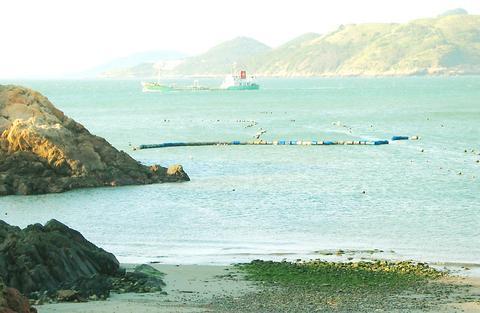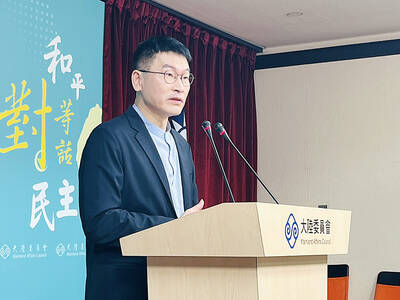The Matsu Islands -- a long-time defense post about 210km northwest of Taiwan's northern tip and just outside the estuary of the Min River in China's Fujian Province -- is now acting more as an environmental guard post for Taiwan than as a military bastion.
The Environmental Protection Administration has since 1999 operated an air-quality monitoring system in Matsu. In 2001 the administration upgraded the system with advanced precision instruments that measure airborne pollutants in order to provide early warnings about sandstorms.

PHOTO: CHIU YU-TZU, TAIPEI TIMES
The administration is also assisting Matsu authorities and residents in tackling the problem of water-borne waste from China. Because of lax environmental regulations in China, the islands are being swamped with Chinese junk -- ranging from from bottles to animal carcasses to human bodies.
According to Chen Hsiu-hua (陳秀華), director-general of Lienchiang County's Environmental Protection Bureau, an air-quality monitoring system in Nankan will soon be relocated to a nearby site. The move will make it more sensitive to pollutants from China.
"Information about Chinese sandstorms that we gather here in Matsu gives Taiwan three to four hours to prepare for a possible strike of bad air," Chen said.
The station is capable of making precise measurements of fine particulate matter (known as PM10) and long-range air pollutants of concern, including ozone, sulfur dioxide and carbon monoxide, according to Chu Yu-chi (
Despite dust created by 130 construction sites, Matsu does not produce an excessive amount of air pollutants, environmental officials said. On the Pollutant Standards Index -- on which a score of 100 or higher is considered unhealthy for humans, especially those who suffer from asthma or other respiratory diseases -- the average reading in Matsu ranges between 20 and 40.
PSI is calculated based on concentrations of a variety of pollutants, including PM10 matter, sulfur dioxide, nitrogen dioxide, carbon monoxide and ozone.
However, PSI levels on Matsu increase significantly -- to 100 or higher -- when Chinese sandstorms send pollutants to the islands. Since 2001, there have been five days on which PSI levels have exceeded 100.
"Air quality information from Matsu makes it possible for Taiwanese residents to take necessary precautions during times of bad air quality. But the long-range transportation of other kinds of pollutants from China deserves more attention," said Lin Neng-huei (
Extremely dry conditions in the deserts of Central Asia and Mongolia often trigger sandstorms during the winter. Scientists have said that desertification caused the Gobi Desert to expand at a rate of 2.4 percent per year in the late 1990s.
As the Gobi Desert creeps south, not only China's heartland but also neighboring countries are being hammered with increasingly regular sandstorms.
The phenomenon has triggered research about transcontinental sandstorms in many countries, including Taiwan, South Korea and Japan.
In Taiwan, sandstorms from China were first noticed in April 1988, when the concentration of particulate matter in the air increased dramatically. In recent years, sandstorms have become more frequent due to drought and overgrazing in China.
Because Taiwan appears to suffer disproportionately from Chinese sandstorms, university researchers affiliated with the administration have since 2001 been charged with conducting in-depth research and analyzing data collected by satellite, laser radar and air quality monitoring stations.
In February, the EPA's research into Chinese sandstorms suggested that various kinds of fungi, originating in Mongolia, were being carried via sandstorms to Taiwan. However, a correlation between the presence of fungi in sandstorms and the transmission of human disease remains unclear.
Lin said that if a new air-quality monitoring system could be established somewhere in the area of Jade Mountain at about 3,000m above sea level, air-quality data collected in Matsu and elsewhere in Taiwan would become relatively complete.
"Regional air-quality data collected in East Asia, including eastern China and Taiwan, could be analyzed together with that available in Hawaii. Our portrait of long-range transportation of airborne pollutants would become clearer," Lin said.
In addition to airborne pollutants, the EPA has also assisted Matsu residents in fighting water-borne waste from China.
In the last decade, Matsu residents have suffered the ill effects of rapid industrialization in China. The lack of advanced landfill technologies in China has resulted in coastal pollution in Matsu.
At a Chukuang Township pier where tourists go ashore to visit a lighthouse built in 1842 by British engineers, floating garbage seems to dampen both the visitors' and the hosts' spirits.
"The situation during rainy times is really awful," said Chukuang Township Chief Wang Ta-chieh (
Water-borne waste from China usually arrives in the Matsu Islands between November and January because of the wind direction in winter. Heavy rain during the typhoon season also boosts the amount of garbage from China.
According to Chen Yu-li (陳玉利), a specialist with the county's Environmental Protection Bureau, about 296 tonnes of waste from China's Fujian Province were collected by sanitation workers in Matsu last year. Nearly three-quarters of it was wood, straw, leaves, seaweed and other natural materials flushed down the Min River.
But Chen said that the waste also included medical equipment, clothes, bottles, cans, and the carcasses of animals such as chickens, pigs and sheep. Human bodies have been found from time to time.
"Sometimes fishing boats have malfunctioned simply because of running into fishing nets that people have thrown away," Chen Yu-li said.
Also, because it lies among heavily-trafficked shipping routes, Matsu suffers from litter that comes from merchant marine vessels.
The local government in the spring and fall carries out voluntary activities in which residents and soldiers clean the beaches -- but mountains of garbage remain.
Last October, residents of Nioujiao Village in Nankan, which is particularly hard hit by water-borne Chinese waste, decided to protect their coast by building a floating boom. They lashed together barrels in a line about 300m from the coast to prevent Chinese waste from floating into their village.
Marina Cheng (

LOW RISK: Most nations do not extradite people accused of political crimes, and the UN says extradition can only happen if the act is a crime in both countries, an official said China yesterday issued wanted notices for two Taiwanese influencers, accusing them of committing “separatist acts” by criticizing Beijing, amid broadening concerns over China’s state-directed transnational repression. The Quanzhou Public Security Bureau in a notice posted online said police are offering a reward of up to 25,000 yuan (US$3,523) for information that could contribute to the investigation or apprehension of pro-Taiwanese independence YouTuber Wen Tzu-yu (溫子渝),who is known as Pa Chiung (八炯) online, and rapper Chen Po-yuan (陳柏源). Wen and Chen are suspected of spreading content that supported secession from China, slandered Chinese policies that benefit Taiwanese and discrimination against Chinese spouses of

PROMOTION: Travelers who want a free stopover must book their flights with designated travel agents, such as Lion Travel, Holiday Tours, Cola Tour and Life Tours Air Canada yesterday said it is offering Taiwanese travelers who are headed to North America free stopovers if they transit though airports in Japan and South Korea. The promotion was launched in response to a potential rise in demand for flights to North America in June and July next year, when the US, Canada and Mexico are scheduled to jointly host the FIFA World Cup, Air Canada said. Air Canada offers services to 13 of the 16 host cities of the tournament’s soccer games, including Toronto and Vancouver; Mexico City, Guadalajara and Monterrey in Mexico; Atlanta, Georgia; Boston; Dallas; Houston;

ALIGNED THINKING: Taiwan and Japan have a mutual interest in trade, culture and engineering, and can work together for stability, Cho Jung-tai said Taiwan and Japan are two like-minded countries willing to work together to form a “safety barrier” in the Indo-Pacific region, Premier Cho Jung-tai (卓榮泰) yesterday said at the opening ceremony of the 35th Taiwan-Japan Modern Engineering and Technology Symposium in Taipei. Taiwan and Japan are close geographically and closer emotionally, he added. Citing the overflowing of a barrier lake in the Mataian River (馬太鞍溪) in September, Cho said the submersible water level sensors given by Japan during the disaster helped Taiwan monitor the lake’s water levels more accurately. Japan also provided a lot of vaccines early in the outbreak of the COVID-19 pandemic,

The US approved the possible sale to Taiwan of fighter jet spare and repair parts for US$330 million, the Pentagon said late yesterday, marking the first such potential transaction since US President Donald Trump took office in January. "The proposed sale will improve the recipient's capability to meet current and future threats by maintaining the operational readiness of the recipient's fleet of F-16, C-130," and other aircraft, the Pentagon said in a statement. Trump previously said that Chinese President Xi Jinping (習近平) has told him he would not invade Taiwan while the Republican leader is in office. The announcement of the possible arms